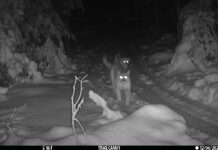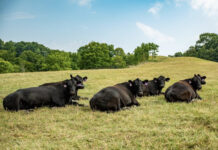Blue moon/you saw me standing alone/without a dream in my heart/without a love of my own.
— Lyrics from a 1934 song by Richard Rodgers and Lorenz Hart
There was a full moon Nov. 21. No big deal, you say, there’s a full moon in most every month. However, this one is what the Maine Farmer’s Almanac, first published in 1818, called a blue moon. When I was a kid, folks often used the expression “Once in a blue moon,” or “Never in a blue moon” to describe something that occurred very rarely, or that might never happen at all.
I didn’t know what the term referred to since I’d never actually seen a blue moon; every moon looked yellow or white or maybe gray to me.
There actually have been several occasions when the moon did look as though it was blue, mainly due to dust, smoke or ashes from some cataclysmic event on earth permeating the atmosphere. One such event occurred in 1883, when the Indonesia volcano Krakatoa erupted, spewing so much ash into the atmosphere that moonbeams passing through the clouds of ash appeared blue or green for several years after.
A full moon occurs every 29 days so it’s possible for there to be two in a single month, although it is somewhat rare, happening on an average of once every 2.7 years. In 2009 there was a full moon on Dec. 2, and another on New Year’s eve, the 31st.
Definition
The common perception today is that a second full moon appearing in any single month is a blue moon, however the Maine Farmers Almanac interpreted a blue moon as being the third full moon of four in any one season — spring, summer, fall or winter — and will always fall between the 20th and 23rd of the months of May, February, August or November, and almost exactly one month prior to the vernal equinox (about March 21), the autumnal equinox (about September 22), the summer solstice (about June 21) and the winter solstice (Dec. 21).
Accordingly, the last true blue moon (according to the Maine Farmer’s Almanac) was May 19, 2008, being the third full moon of the four between the vernal equinox March 20 and the summer solstice June 20.
Full moons that spring occurred March 21, April 20, May 19 and June 18. As can be seen, none of these months had two full moons, although the spring season itself had four. The full moon that just occurred was on Nov. 21, that being the third full moon of the four occurring between the autumnal equinox on Sept. 23 (also the date of the first full moon) and the winter solstice Dec. 21.
Dec. 21, 2010, is the date of two lunar events: the fourth full moon of the season, as well as a total eclipse of that moon.
The original need to identify a thirteenth moon in a given year arose centuries ago in Europe from the need to calculate the exact date of Easter on the Christian ecclesiastical calendar. The normal year had 12 full moons and each of these had a name.
History. According to Biblical clues, Easter must fall on the 14th day of the Paschal Moon, which corresponds to the vernal equinox. A 13th full moon in any given year had no name and threw off these calculations, so the blue moon was dreamed up to keep things on track.
Native Americans put great store in the phases of the moon, using moons instead of months to mark the passing of time. Who can forget the Indian chief in the old western movies saying sonorously, “many moons ago,” this or that occurred.
Moon names
The most common names for the full moons among the native people were as follows: January-wolf moon, in reference to the hungry howling of wolves around the camps. February-snow moon, because across northeastern America the heaviest snows fell in this month. Some tribes used the name hunger moon, because food was scarce at this time.
March-worm moon; as the ground warmed, earthworms appeared. European settlers called this the Lenten moon. April-pink moon, after a wildflower that bloomed at this time; sometimes known as sprouting grass moon. May-flower moon, because of the many wildflowers that bloomed in great profusion in May. Also called corn planting moon, as this was the time to plant corn or maize.
June-strawberry moon, because of the sweet, red strawberries ripened during this month. July-buck moon, so called because buck deer sprout their new antlers at this time. Also known as hay moon because grass was cut at this time.
August-sturgeon moon, due to the huge spawning runs of these fish when they were very easy to catch. Sometimes called green corn moon or grain moon as well. September-harvest moon or corn moon, when Native Americans harvested corn, pumpkins, squash, beans and other staples. October-hunter’s moon. The month when summer-fattened game was taken and stored for the long winter ahead.
November-beaver moon, or frosty moon, the time to set beaver traps before the ponds froze. December-cold moon, or long nights moon, for obvious reasons. European settlers called it the moon before Yule. It’s not recorded what name the Native Americans gave the blue moon.
Planting rules
Farmers used to plant and harvest crops, butcher animals and do many other chores according to the phases of the moon — for example, potatoes were always planted during the “dark of the moon,” and nothing was ever planted on the day of a full moon or a new moon. The rules for farming by the moon are too numerous and complex to squeeze into this story — maybe another time.
(Send suggestions, comments or questions to Sam Moore in care of Farm and Dairy, P.O. Box 38, Salem, OH 44460-0038; or via e-mail to: editorial@farmanddairy.com.)












